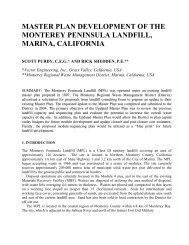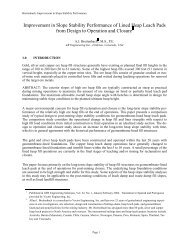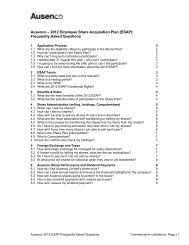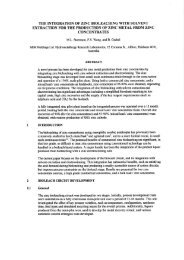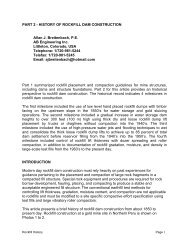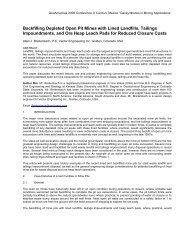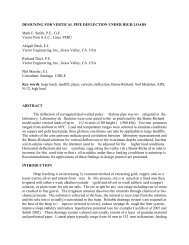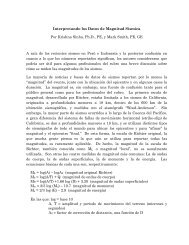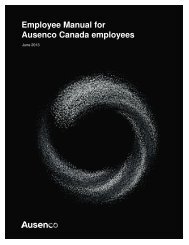Summary of Rockfill Placement and Compaction ... - Ausenco
Summary of Rockfill Placement and Compaction ... - Ausenco
Summary of Rockfill Placement and Compaction ... - Ausenco
Create successful ePaper yourself
Turn your PDF publications into a flip-book with our unique Google optimized e-Paper software.
PART 1 - SUMMARY OF ROCKFILL PLACEMENT AND COMPACTIONGUIDELINES FOR MINE STRUCTURESAllan J. Breitenbach, P.E.AB Engineering Inc.Littleton, Colorado, USATelephone: 1/720-981-5244Telefax: 1/720-981-5245Email: ajbreitenbach@hotmail.comLarge quantities <strong>of</strong> mine waste rock material (non-ore overburden) are generally availablefrom open pit mine cuts for use in water storage <strong>and</strong> tailing impoundment embankment fills,as well as for site grading fills beneath heap leach pads <strong>and</strong> process facilities. The minewaste rock, already blasted or ripped <strong>and</strong> loaded into rock haul trucks, can be economicallyhauled <strong>and</strong> placed in embankment fills several miles from the open pit mine for less costthan local borrow development within the planned impoundment or leach pad grading filllimits. This article discusses rockfill placement <strong>and</strong> compaction guidelines successfullyused to construct stable engineered fill structures at mine sites, including some <strong>of</strong> thelargest tailing dam structures in California, Nevada, South Dakota <strong>and</strong> Washington.INTRODUCTIONModern day rockfill construction must rely heavily on past experiences for guidance indetermining acceptable procedures for the placement <strong>and</strong> compaction <strong>of</strong> large rockfragments in a compacted fill structure. The conventional earthfill field <strong>and</strong> laboratory testmethods for controlling lift thickness, gradation, moisture content, <strong>and</strong> compaction are notapplicable to rockfills <strong>and</strong> must be modified to a site specific compactive effort specificationusing large-scale test fills <strong>and</strong> heavy vibratory roller compactors. Based on rockfillconstruction experience <strong>and</strong> engineering studies on several large-scale test fills, a generalset <strong>of</strong> guidelines can be established for rockfill placement <strong>and</strong> compaction as discussedbelow. Typical rockfill placement <strong>and</strong> compaction operations, as well as large scale rockfilldensity <strong>and</strong> gradation testing are shown on Photos 1 to 7.<strong>Rockfill</strong> Guidelines Page 1
GUIDELINES FOR ROCKFILL PLACEMENT AND COMPACTIONLift Thickness:Roller Type:Maximum loose lift thickness is governed by maximum rock size <strong>and</strong> type <strong>of</strong>compaction equipment. Optimum rockfill loose lift thicknesses are generally about 18to 30 inches (0.5 to 0.8 m) with maximum rock sizes limited to two thirds <strong>of</strong> the liftthickness. Larger rock sizes can be incorporated into the fill provided the rock doesnot protrude above the fill surface to hinder compaction.Lifts approaching or exceeding 3 feet (1 m) are generally beyond the effectivecompaction limit <strong>of</strong> conventional 10 to 20 ton vibratory steel drum rollers commonlyused on modern day rockfills. Bulk density <strong>and</strong> gradation tests <strong>and</strong> settlementversus roller pass curves are recommended in test fills for large rockfill dams orother critical rockfill structures to determine the maximum lift thickness acceptablefor the compaction roller used on site.Experience indicates the most efficient rockfill compactors are vibratory steel drumrollers with vibrations in the range <strong>of</strong> 1,200 to 1,500 vpm, roller speed <strong>of</strong> about 2mph (3.2 km/h), a minimum static drum weight <strong>of</strong> 8 tons on level ground, <strong>and</strong> aminimum operating dynamic force <strong>of</strong> 15 tons. Self-propelled rollers are the mostmaneuverable, especially at abutment contacts, for better coverage <strong>and</strong> compactioncompared to rollers pulled by tractors. Vibratory rollers are effective in the forwarddirection, which produces the maximum downward force from eccentric rotatingshafts in the drum. Modern self-propelled double-drum <strong>and</strong> single-drum rollersgenerally can reverse the rotating shaft for maximum compaction in the forward <strong>and</strong>reverse direction without having to turn around at the end <strong>of</strong> each pass.Roller Passes:Optimum roller passes are determined from surveyed settlement versus roller passcurves developed in large-scale test fills. The general limit is between 4 to 6 passes.More than 6 passes tends to crush <strong>and</strong> pulverize the rockfill surface without addingsignificant compaction to the lower part <strong>of</strong> the lift. Each roller pass should<strong>Rockfill</strong> Guidelines 2
Gradation:overlap the edge <strong>of</strong> preceding passes for 100 percent roller pass coverage on thesurface. As a general "rule <strong>of</strong> thumb", the acceptable number <strong>of</strong> roller passes shouldbe set at 80 percent <strong>of</strong> the total surveyed settlement in eight passes on a testsection, according to Corps <strong>of</strong> Engineers test procedures. The average settlement <strong>of</strong>at least 5 survey control points is recommended for each 2 passes <strong>of</strong> the rollercompactor to determine the acceptable number <strong>of</strong> passes.<strong>Rockfill</strong>s for compacted dam structures are generally placed in transitional zoneswith the most coarse <strong>and</strong> competent rock placed in the outer shell <strong>and</strong> finer moreweathered rock placed in the interior or adjacent to earthfill filter drain <strong>and</strong> corematerials. A similar transition zone is developed for leach pad site grading fills withthe finer rock materials placed beneath the pad soil subgrade <strong>and</strong> overlyinggeomembrane liner system.Well-graded rockfills with small voids tend to increase the in-place density <strong>and</strong>provide a stable mass for minimizing post-construction settlement. Poorly gradedrock with large voids is sometimes desirable on the upstream shell <strong>of</strong> a waterstorage reservoir for drainage during reservoir rapid drawdown conditions <strong>and</strong> inspillway areas for erosion protection <strong>and</strong> energy dissipation.Oversized rocks are generally placed on the downstream or exterior rockfill slopes<strong>and</strong> in downstream outlet/spillway plunge pools for erosion <strong>and</strong> energy dissipationpurposes. Occasional extremely large oversized rock can be incorporated intorockfills provided no overhangs occur <strong>and</strong> the surrounding rockfill is compactedagainst the large rock pieces similar to compaction techniques against the rockabutments. Phased downstream raises to existing rockfill dams can incorporate thenew rockfill into the oversized rock on the downstream slope <strong>of</strong> an existing damprovided the large rocks are not clustered.Moisture Conditioning:In the past, rockfills for water storage embankments were dumped in thick loose lifts<strong>of</strong> typically 35 to 165 feet (11 to 50 m) <strong>and</strong> flooded with water to consolidate therockfill to about 85 percent <strong>of</strong> its total settlement. Modern rockfills since the 1960'sare placed in thin controlled lifts <strong>and</strong> compacted with vibratory compactors so thatmoisture conditioning requirements are not as critical to minimize post-constructionsettlement. Wetting is generally accomplished on the fill area unless water truckshave access to the rock borrow area. As with earthfill materials, moistureconditioning is desirable in the rock borrow areas for better mixing <strong>of</strong> moisture <strong>and</strong>materials during excavation, loading, dumping, <strong>and</strong> spreading for compaction.However, development <strong>of</strong> rock borrow areas involves blasting or ripping operationsthat sometimes make the borrow surface too rugged for conventional water truckswith spray bars.<strong>Rockfill</strong> Guidelines 3
Overbuild:Ideally the rock borrow should be sufficiently wetted so that no dust occurs when thehaul truck or scraper dumps a load on the fill surface for spreading <strong>and</strong> compacting.Wetting <strong>of</strong> the rockfill in the fill area should be accomplished prior to spreading thenew lift or following compaction <strong>of</strong> the lift. Wetting immediately prior to compactionby vibratory rollers significantly dampens the dynamic force <strong>of</strong> the compactor forinefficiency in compaction. The exception to this rule is a clean rockfill, which can beflooded with water <strong>and</strong> rapidly drained before compaction begins.An ideal rockfill moisture content contains minus 3/4 inch (19 mm) materials thatappear near optimum moisture, not overly wet or overly dry, for enhanced vibratorycompaction. Wetting before placement <strong>of</strong> each new lift is encouraged to providebonding between successive lifts without the need to scarify the compacted rockfillsurface. There is no need to scarify compacted rockfill surfaces provided the surfaceconsists <strong>of</strong> clean rock or is moist.Modern day compacted rockfills that are relatively well graded show minimal postconstructionsettlements <strong>of</strong> the order <strong>of</strong> 0.2 feet per 100 feet <strong>of</strong> height (0.2 m per 100m). For compacted large earth-rockfill dam structures with a relatively thin centralcore or upstream earthfill core/impervious liner facing, about 0.5 feet (0.15 m) crestoverbuild per 100 feet (30 m) <strong>of</strong> dam height appears conservative. For largecompacted earth-rockfill dams with relatively thick central earthfill cores, about 1 feet(0.3 m) minimum crest overbuild per 100 feet (30 m) <strong>of</strong> dam height is reasonable tocounteract the long-term consolidation <strong>of</strong> core materials (post-constructiondissipation <strong>of</strong> excess pore water pressures in fine-grained core materials).<strong>Rockfill</strong> Guidelines 4
REFERENCESBreitenbach, A. J. (1993), <strong>Rockfill</strong> <strong>Placement</strong> <strong>and</strong> <strong>Compaction</strong> Guidelines, GeotechnicalTesting Journal, ASTM, Philadelphia, Pennsylvania, Vol. 16, No. 1, pp. 76 to 84.Gloze, Alfred R. et al (1977), Design <strong>of</strong> <strong>Rockfill</strong> Dams, Chapter 7 - H<strong>and</strong>book <strong>of</strong> DamEngineering.Pope, R. J. (1966), Evaluation <strong>of</strong> Cougar Dam Embankment Performance, ASCE SoilMechanics <strong>and</strong> Foundations Division Conference, Berkeley, California, ASCE, New York.Sherard, J. L., Woodward, R. J., Gizienski, S. F., <strong>and</strong> Clevenger, W. A. (1963), Earth <strong>and</strong>Earth-Rock Dams, Wiley, London.United States Department <strong>of</strong> the Interior, Bureau <strong>of</strong> Reclamation (1974), <strong>Rockfill</strong> Dams,Chapter 7, Design <strong>of</strong> Small Dams, Water Resources Technical Publication, Denver,Colorado.<strong>Rockfill</strong> Guidelines 5



